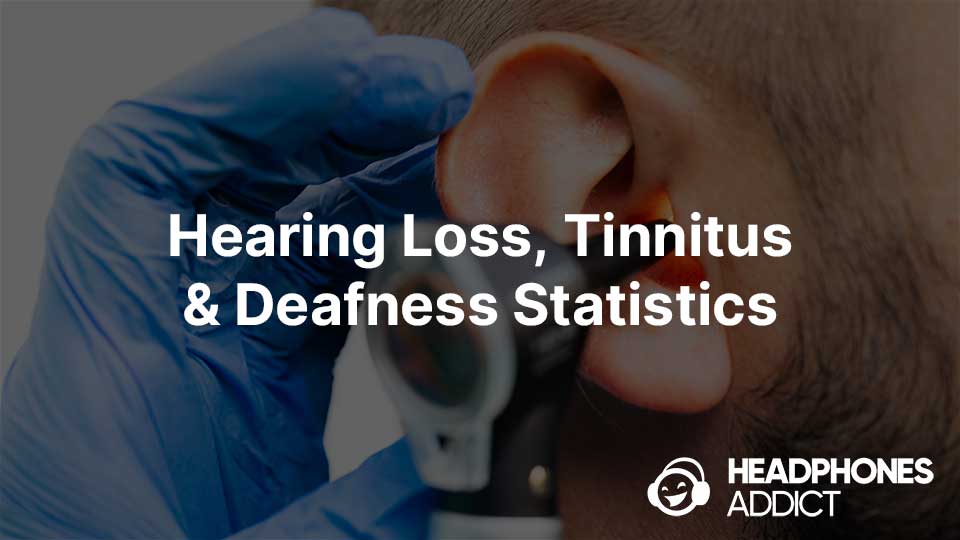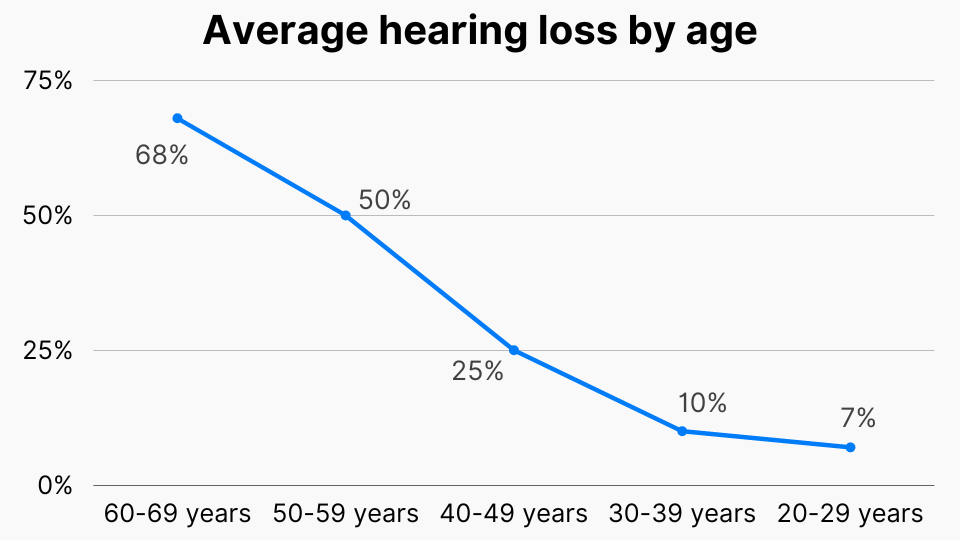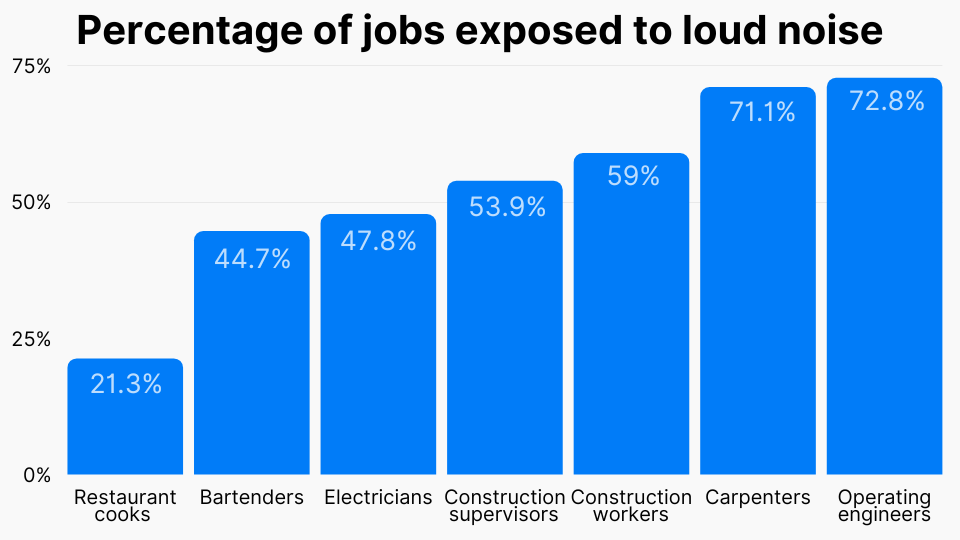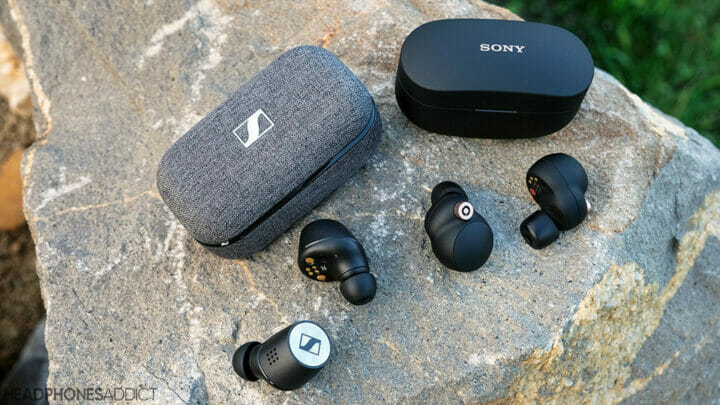This is the most comprehensive list of hearing loss, tinnitus and deafness statistics for the world and the USA.
Here you can find over 50 latest stats on hearing loss prevalence, causes of hearing loss in adults, veterans, and children, how it impact people by age and more.
There’s even data on how headphones and earbuds impact the hearing of young people.

Contents:
- Hearing Loss and Deafness Statistics
- Hearing Loss by Age Statistics
- Noise-Induced Hearing Loss Statistics
- Hearing Loss in Children Statistics
- Headphones and Earbuds Hearing Loss Statistics
- Hearing Aid Statistics
- Tinnitus Statistics
Important Hearing Loss, Tinnitus & Deafness Statistics
- According to World Health Organization (WHO), over 1.5 billion people, or around 18%, live with hearing loss.
- CDC estimates around 15% of American adults, or 38.7 million people, have hearing loss.
- Slightly over 50% of American adults said they have some trouble hearing, but only 1 in 20 got treatment.
- It’s estimated that less than 5% of Americans are deaf, with around 11 million (3.3%) hard of hearing and around 1 million (0.3%) functionally deaf.
- Almost 50% of people older than 75 years have some hearing loss.
- According to CDC, almost a quarter of Americans, or 39.4 million people aged 20-69 years, have noise-induced hearing loss in one or both ears.
- 1.25 million US veterans have hearing loss and almost 2 million have tinnitus.”
- According to WHO, up to 0.5% or 5 of 1000 babies are born with hearing loss or have it soon after.
- 10% of young people from 13 to 23 years old who listen to headphones and earbuds when commuting have some level of permanent hearing loss.
- 7.1% of Americans over the age of 45 years use a hearing aid.
- From 15 to 20% of the global population suffers from some form of tinnitus. That’s 1.2 to 1.6 billion people worldwide.
Hearing Loss and Deafness Statistics
How many people have hearing loss globally?
According to World Health Organization (WHO), over 1.5 billion people, or around 18%, live with hearing loss.
Source: WHO, Deafness and hearing loss.

- WHO predicts the number to rise to over 2.5 billion by 2050.
- Over 1 billion young people aged 12-35 risk hearing loss due to dangerous exposure to loud sounds.
- $980 billion is the yearly cost of global unaddressed hearing loss.
Who is considered a person with hearing loss?
A person with hearing loss doesn’t hear like a normal person, defined as a minimal 20 dB lower hearing threshold in one or both ears. People can have mild, medium/moderate, severe, and disabling hearing loss.
More than 430 million people, or over 5% of the global population, need treatment for their disabling hearing loss.
(WHO 2)
Disabling or profound hearing loss is greater than 35 dB in the better ear.
- The majority, almost 80% of people with disabling hearing loss, come from low- and middle-income countries.
- Over 25% of people over the age of 60 have disabling hearing loss.
The older you get, the more likely your hearing loss “accumulates” and gets to the point of having a noticeable impact on your life.
How many Americans have hearing loss?
CDC estimates around 15% of American adults, or 38.7 million people, have hearing loss.
(CDC 1, NIH 4)
Hearing loss is prevalent in older people.
- 91% of Americans with hearing loss are 50 years old or older.
- It’s estimated that 25.8 million Americans older than 12 years have a mild hearing loss.
- 12.9 million Americans have moderate or more severe hearing loss.
Yet few Americans test their hearing.
Only 20% of US adults said they had their hearing tested in the last 5 years.
(ASHA)
Hearing tests are 3 times less common than vision tests.
- Compare this to 61% of US adults who had their vision tested.
| Medical services received (last 5 years) | % |
|---|---|
| Vision test | 61% |
| Vaccinations | 59% |
| Blood pressure monitoring | 52% |
| Cholesterol screening | 41% |
| Mammograms (women) | 41% |
| Prostate exam (men) | 24% |
| Colonoscopy | 23% |
| Hearing test | 20% |
| Bone density test | 14% |
The reason could be that:
60% of American adults don’t feel the need for treatment because their hearing is fine in some situations.
- Most mild hearing loss is untreated.
People don’t think it’s anything wrong with their hearing because they can sometimes hear normally.
Also, kids have hearing loss too.
12.5% of school-age kids in the US have some hearing loss.
(American Academy of Pediatrics)

- Over 5 million 6–19-year-olds have hearing loss in one or both ears.
- Most kids have noise-induced hearing loss in 1 ear for 1 frequency only.
In some countries, the numbers are even bigger.
According to the Australian government, more than a third of Australians have experienced noise-induced hearing damage
(Australia Government Department of Health)
While some hearing damage is temporary and can heal, permanent hearing loss doesn’t.
- Around 3.6 million Australians have some degree of permanent hearing loss.
- Over 1.3 million Australians have a hearing condition that would be preventable with proper treatment.
Slightly over 50% of American adults said they have some trouble hearing, but only 1 in 20 got treatment.
(ASHA)
Hearing loss is common as people age, but it’s still not recognized as a condition people should seek treatment for.
How does hearing loss impact the lives of Americans?
| Difficulty hearing when there is background noise | 60% |
| Ringing, hissing, or other sounds in ears | 47% |
| Have to strain to understand conversation | 46% |
| Hard to follow the conversation between 2 people | 41% |
| Misunderstanding others and responding inappropriately | 39% |
| People often have to repeat what they say to me | 34% |
| Many people I talk to don’t speak clearly | 34% |
| People complain I turn the TV volume too high | 31% |
| Family and friends tell me I might have trouble hearing | 29% |
| Hard to understand women and children | 21% |
| I avoid interaction with others because I can’t hear them | 16% |
What percentage of people are deaf worldwide?
More than 70 million deaf people represent over 0.875% of the world population.
(World Federation of the Deaf)
Over 80% of the functionally deaf live in developing countries.
What percentage of Americans are deaf?
It’s estimated that less than 5% of Americans are deaf, with around 11 million (3.3%) hard of hearing and around 1 million (0.3%) functionally deaf.
(Survey of Income and Program Participation – SIPP)
- More than half of Americans with deafness or hearing loss are older than 65 years.
- Kids under 18 years old represent a small share, under 4%.
- New Jersey has the lowest share of deaf and hard of hearing population, and West Virginia has the highest.
What are the primary causes of hearing loss in general?
- Damaged inner ear due to exposure to loud noises and aging
- Ruptured eardrum due to severe noise
- Genetics
- The steady build-up of earwax
- Ear infections
- Bone growth and tumors
- Natural aging process
Men vs. women hearing loss differences
Men struggle with hearing loss more than women.
21.9% of men and 15.8% of women over 45 years old suffer from hearing loss even when using a hearing aid.
Men represent 58% and women 42% of people who have difficulties hearing even with a hearing aid.
- But men are almost twice as likely to experience profound hearing loss or deafness.

Here’s data on hearing loss by gender and age from CDC (US adults, 45 years old+):
| Hearing difficulties by gender and age | Men | Women |
|---|---|---|
| Total | 21.9% | 15.8% |
| 45-64 years old | 16.7% | 10.6% |
| 65 or older | 30.9% | 23.5% |
(CDC 1)
Hearing Loss by Age Statistics
What is average hearing loss by age?
Almost 70% of people 60-69 years old have hearing loss, while only 7% of young people aged 20-29. More data below.
Here’s a table of hearing loss by age (difficulties hearing a high-pitched sound):
| Age | Percentage |
|---|---|
| 20-29 years | 7% |
| 30-39 years | 10% |
| 40-49 years | 25% |
| 50-59 years | 50% |
| 60-69 years | 68% |
We charted the hearing loss occurrence in population by age group. You can clearly see that age has a high correlation and possibly a causation as well.

How many adults over the age of 75 have hearing loss?
Almost 50% of people older than 75 years have some hearing loss.
(NIH – National Institute on Deafness and other Communication Disorders)
- Also, around 1 in 3 Americans in the age group of 65 and 74 years have hearing difficulties.
In the United Kingdom, the statistics aren’t much different.
- Over 40% of people 50 years old or older have hearing loss.
- The percentage rises to over 70% with people older than 70 years.
(Office for National Statistics)
What’s the average age of people using hearing aids?
The average age of a person who starts using hearing aids is 74 years.

- Most people have difficulties with hearing for an average of 10 years before starting to use a hearing aid.
(National Library of Medicine)
(National Library of Medicine)
What percent of people between the ages of 45 and 65 suffer from Presbycusis (age-related hearing loss)?
Here’s the table with the percent of people suffering from Presbycusis by age:
| Presbycusis by age | % |
|---|---|
| 44-54 years old | 11% |
| 55- 64 years old | 25% |
| 65-84 years old | 43% |
Age-related hearing loss increases with age.
(NIH 2)
Presbycusis is estimated:
- It affects more than 50% of the population 75 years old or older.
- A majority of people are 80 years old.
- And almost all people over the age of 90.
It occurs more commonly in men than women, probably due to men being exposed to loud noises more.
- World Health Organization (WHO) predicts that 1.2 billion people over 60 will suffer from Presbycusis by 2025 (globally).
- Over 500 million people will suffer severe hearing loss due to age-related hearing loss.
(WHO 3)
Around 70% of people exposed to severe noise never or rarely use hearing protection.
(National Health and Nutrition Examination Survey)
Noise-Induced Hearing Loss Statistics
How many Americans have noise-induced hearing loss?
According to CDC, almost a quarter of Americans, or 39.4 million people aged 20-69 years, have noise-induced hearing loss in one or both ears.

(CDC 2)
More specifically, CDC found:
% of Americans | Hearing condition |
|---|---|
| 24.4% | Have ear damage |
| 18.2% | Have one damaged ear |
| 6.2% | Have both damaged ears |
- 1 in 8 kids aged 6-19 years has hearing loss due to exposure to loud noise.
It’s similar in Canada:
Around 19% of Canadians, or 4.6 million people from 20 to 79 years old, have at least minimal hearing loss in human voice frequencies (0.5, 1, 2, 4 kHz).
(NIH 3)
What are common causes of noise-induced hearing loss?
There’s no exact data on what actually causes hearing loss in the population, but there is data on what is recognized as most common.
They asked the surveyed what they think are the main causes of noise-induced hearing loss, and here are the results:

Here’s a table of the most recognized causes of hearing loss:
| Recognized causes of hearing loss | Among total |
|---|---|
| Working in a loud environment (construction, manufacturing, etc) | 49% |
| Listening to headphones loudly | 47% |
| Exposing to loud music | 42% |
| Visiting concerts | 36% |
| Wearing headphones for a long time | 36% |
| Going to sporting or other big events | 22% |
| Shooting (hunting) | 19% |
| Playing an instrument | 14% |
| Other | 29% |
Read more on noise pollution.
How many veterans suffer from hearing loss?
1.25 million US veterans have some level of hearing loss. Additionally, almost 2 million have tinnitus (ringing in the ears), mostly due to loud noises from explosions.

- Tinnitus is the #1 disability for military personnel returning home.
- Hearing loss is #2 most common disability for returning military members.
- Over 2.3 million veterans are receiving tinnitus disability compensation.
- Over 1.3 million veterans are receiving hearing loss disability compensation.
One of the reasons could be insufficient hearing protection issued by the military. The Pentagon is already testing new hearing protection methods for the future.
(Military.com, Veterans Benefits Administration)
Noise-induced hearing loss in the workplace
Globally, 16% of severe, disabling hearing loss cases result from workplace noise exposure.
Generally, workplace noise isn’t a big problem. But some occupations are still exposed.
| 75% | of workers in civilian jobs are exposed to medium levels of noise |
| 13.3% | are exposed to loud noises |
| 0.7% | are exposed to very loud noises |
Jobs in construction and extraction lead to the biggest noise exposure.
- 7.9% of construction and extraction jobs are exposed to very loud noises.

Here’s a table of the loudest jobs and their percentage of exposure to loud noise:
| Job: Exposure to noise | Medium | Loud |
|---|---|---|
| Operating engineers & equip. operators | / | 72.8% |
| Carpenters | / | 71.1% |
| Construction workers | 31.7% | 59% |
| Construction supervisors & extraction workers | 33.3% | 53.9% |
| Electricians | 38.9% | 47.8% |
| Bartenders | 46.7% | 44.7% |
| Restaurant cooks | 77.4% | 21.3% |
Hearing Loss in Children Statistics
How many people are born deaf?
According to WHO, up to 0.5% or 5 of 1000 babies are born with hearing loss or have it soon after.

(WHO 5)
How many kids have hearing loss?
There are multiple sources with different findings by age:
- 14.9% of children 6-19 years old have hearing loss (CDC’s Third National Health and Nutrition Examination Survey)
- 0.5% of children 3-17 years old have hearing loss (CDC’s National Health Interview Survey)
- 0.17% of babies have hearing loss (CDC’s Hearing Screening and Follow-up Survey)
- 0.14% of 8 years old children have hearing loss (CDC’s Metropolitan Atlanta Developmental Disabilities Surveillance Program)
(CDC 3)
What is the most common cause of childhood hearing loss?
Around 60% of the time, the main cause of hearing loss in children are ear infections and birth complications.
(WHO 5)
What are childhood diseases that cause hearing loss?
More than 30% of hearing loss in children is caused by diseases like measles, meningitis, rubella, mumps, and ear infections.
Headphones and Earbuds Hearing Loss Statistics
How do headphones and earbuds cause hearing loss?
Regular exposure to loud music from your headphones can permanently damage your ears, resulting in a loss of hair cells in the inner ear, the cochlea.
The tiny hair cells are responsible for sending sound messages to the brain. When damaged, it can lead to permanent hearing loss.
According to the World Health Organization, nearly 50% of people aged 12-35 years could be exposed to unsafe sound levels from using personal audio devices.

In other words, young people listen to music too loudly. This results in long or repeated exposure to unsafe volume and ear damage. Here’s an article on how to avoid hearing loss from headphones.
How many people have hearing loss due to headphones?
10% of young people from 13 to 23 years old who listen to headphones and earbuds when commuting have some level of permanent hearing loss.
(The Ohio State University Wexner Medical Center)
European studies show that blasting loud music to your ears permanently affects hearing, even for younger generations.
How many kids have hearing loss due to headphones?
WHO estimates over 1 billion young people aged 12-35 years are risking hearing loss due to listening to music loudly.
(WHO 4)
- Since 1990 hearing loss in teenagers has increased by around 30%, mainly due to portable music listening.
- 1 in 5 teenagers will have some level of hearing loss.
Read more on teens:
How loud is too loud according to science?
Here are CDC guidelines for loud noises:
| Sounds and noises | Avg. sound level (dB) | Potential damage |
|---|---|---|
| Normal breathing | 10 | No damage |
| Soft whisper | 30 | No damage |
| Normal conversation, air con | 60 | No damage |
| Washing machine, dishwasher | 70 | Can be annoying |
| Gas lawnmowers, power tools | 80-85 | Damage after 2 hours |
| Motorcycle | 95 | Damage after 50 min |
| Loud radio, TV, headphones, bars | 105-110 | Damage after 5 min |
| Fireworks | 140-150 | Immediate pain and injury |
How long should you listen to headphones to stay safe?
The question isn’t how long but how loudly. Here are the general recommendations:
| Headphones volume in % | Avg. volume (dB) | Max listening time |
|---|---|---|
| 50% | < 70 dB | No limit |
| 60% | 70-75 dB | 24 hours |
| 70% | 80-85 dB | Over 8 hours |
| 80% | 90 dB | Under 8 hours |
| 90% | 100 dB | Under 2 hours |
| 100% | 110-120 dB | Under 20 min |
The louder your headphones, the less time it takes to damage your hearing.
If you keep the volume at around 50%, you can listen safely indefinitely.
Do bone conduction headphones cause hearing loss?
The bone conduction technology does not cause hearing loss. But if you listen to bone conduction headphones too loudly, it can lead to hearing loss.
What happens if you wear headphones too much?
Odds are the time that you listen to music loudly accumulates over time and can lead to hearing loss. But if you keep the volume generally low, then you can listen to headphones as much as you want.
Do headphones and earbuds cause hearing loss?
Headphones and earbuds alone don’t cause hearing loss. The way you use them can. Just like a loud sound from any other source can permanently damage your hearing, so can your headphones. Practice safe listening to avoid hearing damage.
Hearing Aid Statistics
Hearing aid usage: How many people use hearing aids?
7.1% of Americans over the age of 45 years use a hearing aid.
(CDC 4)

- 8.9% of men and 5.4% of women aged over 45 years use hearing aids.
- Of all hearing aid users in the US, 62% are men, and 38% are women.
- Hearing aid use increases with age: 2.3% of people who use hearing aid are aged 45-64, and 14.4% are over 65 years old.
The sales of hearing aids is increasing.
Here’s a table of global sales of hearing aid per year:
| Year | Units of hearing aid sold |
|---|---|
| 2020 | 14.12 million |
| 2019 | 17.06 million |
| 2018 | 16.04 million |
| 2017 | 15.05 million |
| 2016 | 14.2 million |
| 2015 | 13.68 million |
What percentage of hearing loss can be treated with hearing aids?
95% of hearing loss cases in the US can be treated with hearing aids, and the other 5% are treated surgically.
(Better Hearing Institute)
Only around 20% of the people who can benefit from hearing aids actually use them.
Hearing aids industry market size
Here’s a table of hearing aids market size estimates:
| Year | Market size |
|---|---|
| 2029 (estimate) | $17.68 billion |
| 2022 | $10.23 billion |
| 2021 | $9.68 billion |
- Fortune Business Insights estimates the growth until 2029 to be 8.1% CAGR.
Hearing aids market share by company:
| Company | Share of the market |
|---|---|
| Sonova | 31% |
| Demant | 30% |
| Sivantos/Widex | 19% |
| GN ReSound | 15% |
| Starkey | 4% |
| Others | 1% |
Tinnitus Statistics
How many people have tinnitus worldwide?
15% to 20% of the global population suffers from some form of tinnitus. That’s 1.2 to 1.6 billion people worldwide according to CDC.

- In the US, 11.2% or over 28.9 million Americans (18 years or older) suffer from tinnitus (ringing in the ears), according to CDC.
- About 10% of adult Americans (25.8 million) experienced tinnitus lasting longer than 5 minutes in the past year.
- Around 20 million adult Americans suffer from chronic tinnitus.
- And 2 million US adults have severe tinnitus.
- Obesity, high blood pressure, cardiovascular issues, head injuries, and arthritis increase the likelihood of tinnitus.
(CDC 5)
Tinnitus is a condition where the patient hears a sound that doesn’t exist externally. It’s usually described as ringing in the ears but can manifest as buzzing, clicking, and whistling.
Tinnitus recovery statistics
There is an 80% recovery rate for acute tinnitus but only a 25% recovery rate for more severe, chronic tinnitus.
(AMBOSS)
- Tinnitus is the #1 disability of military veterans due to exposure to loud noises during service.
- Over 90% of tinnitus cases are the result of hearing damage.
- Musicians are 57% more likely to get tinnitus than the general population.
Sources:

Matija Ferjan is a seasoned audio enthusiast reviewing headphones since 2015. He has personally tested hundreds of headphones and earbuds. He’s an active member of the Headphone Audio community and a true nitpicker, always looking for the “best-value-for-money” headphones.



